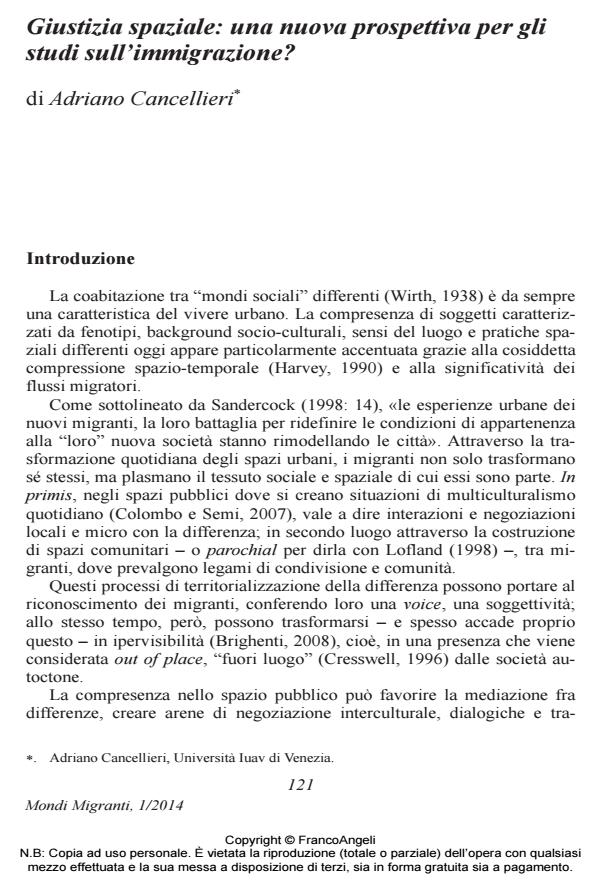Spatial Justice: a new perspective for migration studies?
Journal title MONDI MIGRANTI
Author/s Adriano Cancellieri
Publishing Year 2014 Issue 2014/1
Language Italian Pages 16 P. 121-136 File size 98 KB
DOI 10.3280/MM2014-001008
DOI is like a bar code for intellectual property: to have more infomation
click here
Below, you can see the article first page
If you want to buy this article in PDF format, you can do it, following the instructions to buy download credits

FrancoAngeli is member of Publishers International Linking Association, Inc (PILA), a not-for-profit association which run the CrossRef service enabling links to and from online scholarly content.
The cohabitation among different "social worlds" is increasingly a characteristic of urban spaces. This is mainly due to migrant flows that generated new processes of territorialization of difference. The dominant literature and rhetoric too often started from an assumed representation of difference in urban spaces "always" as something to assimilate, to deconstruct or to defend. Starting from the dissatisfaction towards these dominant representations, the article aims to examine the concept of "spatial justice", largely unexplored in the Italian context, as a possible lens to analyze the processes of territorialization of difference. Using this situated and processual perspective of justice, the attention is focused on the spatialities that are constantly produced and reproduced and on the territorial resources and bonds that could be mobilized or inhibited.
Keywords: Spatial justice, immigration, socio-spatial dialectic, exclusion, spatial agency, multi-scalarity
- Towards a progressive home-making: the ambivalence of migrants’ experience in a multicultural condominium Adriano Cancellieri, in Journal of Housing and the Built Environment /2017 pp.49
DOI: 10.1007/s10901-015-9489-7 - Fare spazio all'accoglienza. Una riflessione sul progetto territoriale di accoglienza integrata di Roccagorga Sandra Annunziata, in MONDI MIGRANTI 1/2017 pp.39
DOI: 10.3280/MM2017-001003 - Grassroots Solidarity for Refugees in Hostile Grounds: Spatial Practices of Bottom-Up Inclusion in Verona Ipek Demirsu, in MONDI MIGRANTI 1/2024 pp.33
DOI: 10.3280/MM2024-001003 - Gentrification and Diversity Lidia Katia C. Manzo, pp.75 (ISBN:978-3-031-35142-6)
- Una città giusta è una città a misura di bambini? Note critiche su un immaginario urbano Caterina Satta, in MONDI MIGRANTI 1/2014 pp.83
DOI: 10.3280/MM2014-001006 - Public spaces in Bologna: mediating social interactions by intercultural placemaking Peiru Chen, in European Planning Studies /2025 pp.1077
DOI: 10.1080/09654313.2025.2480109
Adriano Cancellieri, Giustizia spaziale: una nuova prospettiva per gli studi sull’immigrazione? in "MONDI MIGRANTI" 1/2014, pp 121-136, DOI: 10.3280/MM2014-001008